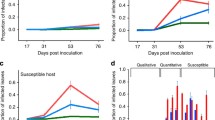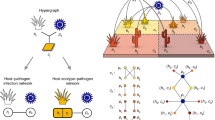Summary
The host-pathogen system, hydra and Hydramoeba hydroxena, was used as an experimental analog to explore properties of epizootics in mixed host species systems, and to determine the contribution of each host species to a measure of overall host community resistance. Epizootics of hydramoeba in systems of two host species were characterized by processes of enhancement and buffering of the infection where one host species is more resistant than the other. More complex host communities were constructed from four hydra species by varying the proportions of each. Community size and number of species were kept constant. Instantaneous infection rates and time infection reached a specific level were judged measures of community resistance or resilience. A Community Resistance Index(R c ) was devised that associated an independent measure of the resistance of each component species in the system with the corresponding abundance of the species in the system. Experimental results indicated significant differences in infection rates and infection level time among the synthetic communities. R c was found predictive of the behavior of the systems under pathogen stress and was considered a realistic measure of community resistance to stress. First order host species interactions were present during the infection process and lead to more complex enhancement processes involving transfer and accumulation of pathogen material. These interactions, however, were not of sufficient magnitude to render the positive R c -community resistance regression insignificant.
Similar content being viewed by others
References
Bailey, N. T. J.: The mathematical theory of epidemics. New York: Hafner 1957.
Berkson, J.: A statistically precise and relatively simple method of estimating the bioassay with quantal response, based on the logistic function. J. Amer. Statist. Ass. 48, 565–599 (1953).
Hairston, N. G., et al.: The relationship between species diversity and stability: an experimental approach with protozoa and bacteria. Ecology 59, 1091–1101 (1969).
Loomis, W. F.: The cultivation of hydra under controlled conditions. Science 117, 565–566 (1953).
Margalef, R.: Diversity and stability: a practical proposal and a model of interdependence. In: Brookhaven Symposia in Biology 22, 25–37 (1969).
McKendrick, A.: The dynamics of crowd infection. Edinb. med. J. (New Series) 57, 117–136 (1940)
Steinhaus, E. A.: The importance of environmental factors in the insect-microbe ecosystem. Bact. 25, 365–373 (1960).
Stiven, A. E.: Experimental studies on the epidemiology of the hostparasite system, hydra and Hydramoeba hydroxena (Entz). I. The effect of the parasite on the individual host. Physiol. Zool. 35, 116–178 (1962).
Stiven, A. E.: Experimental studies on the epidemiology of the host-parasite system, hydra and Hydramoeba hydroxena (Entz). II. The components of a simple epidemic. Ecol. Monogr. 35, 119–142 (1964).
—: The association of symbiotic algae with the resistance of Chlorohydra viridissima (Pallas) to Hydramoeba hydroxena (Entz). J. Invertebrate Path. 7, 356–367 (1965).
—: The influence of host population space in experimental epizootics caused by Hydramoeba hydroxena. J. Invertebrate Path. 9, 536–545 (1967).
—: The components of a threshold in experimental epizootics of Hydramoeba hydroxena in populations of Chlorohydra viridissima. J. Invertebrate Path. 11, 348–357 (1968).
Watt, K. E. F.: Ecology and resource management. New York: McGraw-Hill 1968.
Author information
Authors and Affiliations
Rights and permissions
About this article
Cite this article
Stiven, A.E. The spread of Hydramoeba infections in mixed hydra species systems. Oecologia 6, 118–132 (1971). https://doi.org/10.1007/BF00345714
Received:
Issue Date:
DOI: https://doi.org/10.1007/BF00345714




